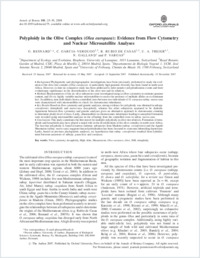Polyploidy in the olive complex (Olea europaea): evidence from flow cytometry and nuclear microsatellite analyses
- Besnard, G. Department of Ecology and Evolution, Biophore, University of Lausanne, Switzerland
- Garcia-Verdugo, C. Royal Botanic Garden of Madrid, Spain - Departamento de Biología Vegetal, Madrid, Spain
- Casas, R. Rubio De Royal Botanic Garden of Madrid, Spain - Departamento de Biología Vegetal, Madrid, Spain
- Treier, Urs A. Biology Department, University of Fribourg, Switzerland
- Galland, Nicole Department of Ecology and Evolution, Biophore, University of Lausanne, Switzerland
- Vargas, P. Royal Botanic Garden of Madrid, Spain
-
15.11.2007
Published in:
- Annals of Botany. - 2008, vol. 101, no. 1, p. 25-30
English
Background: Phylogenetic and phylogeographic investigations have been previously performed to study the evolution of the olive tree complex (Olea europaea). A particularly high genomic diversity has been found in north-west Africa. However, to date no exhaustive study has been addressed to infer putative polyploidization events and their evolutionary significance in the diversification of the olive tree and its relatives. Methods: Representatives of the six olive subspecies were investigated using (a) flow cytometry to estimate genome content, and (b) six highly variable nuclear microsatellites to assess the presence of multiple alleles at co- dominant loci. In addition, nine individuals from a controlled cross between two individuals of O. europaea subsp. maroccana were characterized with microsatellites to check for chromosome inheritance. Key Results: Based on flow cytometry and genetic analyses, strong evidence for polyploidy was obtained in subspp. cerasiformis (tetraploid) and maroccana (hexaploid), whereas the other subspecies appeared to be diploids. Agreement between flow cytometry and genetic analyses gives an alternative approach to chromosome counting to determine ploidy level of trees. Lastly, abnormalities in chromosomes inheritance leading to aneuploid formation were revealed using microsatellite analyses in the offspring from the controlled cross in subsp. maroccana. Conclusions: This study constitutes the first report for multiple polyploidy in olive tree relatives. Formation of tetraploids and hexaploids may have played a major role in the diversification of the olive complex in north-west Africa. The fact that polyploidy is found in narrow endemic subspecies from Madeira (subsp. cerasiformis) and the Agadir Mountains (subsp. maroccana) suggests that polyploidization has been favoured to overcome inbreeding depression. Lastly, based on previous phylogenetic analyses, we hypothesize that subsp. cerasiformis resulted from hybridization between ancestors of subspp. guanchica and europaea.
- Faculty
- Faculté des sciences et de médecine
- Department
- Département de Biologie
- Language
-
- English
- Classification
- Biological sciences
- License
-
License undefined
- Identifiers
-
- RERO DOC 8628
- DOI 10.1093/aob/mcm275
- Persistent URL
- https://folia.unifr.ch/unifr/documents/300655
Statistics
Document views: 199
File downloads:
- Fichier principal: 212
